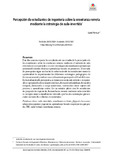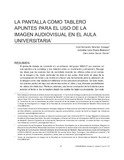Mostrar el registro sencillo del ítem
Perception of Engineering Students on Remote Teaching with the Flipped-Classroom Strategy
Percepción de estudiantes de ingeniería sobre la enseñanza remota mediante la estrategia de aula-invertida
| dc.contributor.author | Pertuz, Said | |
| dc.date.accessioned | 2023-11-28T16:26:08Z | |
| dc.date.available | 2023-11-28T16:26:08Z | |
| dc.date.created | 2021-06-08 | |
| dc.identifier.issn | 1692-3324 | |
| dc.identifier.uri | http://hdl.handle.net/11407/8197 | |
| dc.description | This text reports the results of a perception study of the students of remote teaching of the flipped-classroom method in comparison to two strategies of regular face-to-face teaching: classic elñcturing and learning based on projects. The perceptions study follows a cohort design where the students have the chance of experimenting the different pedagogic strategies in a sequence and perform an assessment at the course’s end. The perception evaluation takes into account six criteria: comprehension, theoretical concepts appropriation, disciplinary formation, integral formation, dedication and academic burden, interaction among the subjects of the process and active learning. In a pilot study with 36 students of an engineering undergraduate program, remote teaching through flipped classrooms is always better or equally valued than those face-to-face strategies in all the considered criteria. | eng |
| dc.description | Este documento reporta los resultados de un estudio de la percepción de los estudiantes sobre la enseñanza remota mediante el método de aula invertida en comparación con dos estrategias de enseñanza-aprendizaje presencial: cátedra clásica y aprendizaje basado en proyectos. El estudio de percepción sigue un diseño de cohorte donde los estudiantes tienen la oportunidad de experimentar las diferentes estrategias pedagógicas de forma secuencial y realizar una evaluación de percepción al final del curso. En la evaluación de percepción, se tienen en cuenta seis criterios: comprensión y apropiación de conceptos teóricos, formación disciplinar, formación integral, dedicación y carga académica, interacción entre sujetos del proceso y aprendizaje activo. En un estudio piloto con 36 estudiantes de pregrado de ingeniería, la enseñanza remota mediante aula invertida es siempre mejor o igualmente valorada que las dos estrategias presenciales en todos los criterios considerados | spa |
| dc.format | ||
| dc.format.extent | p. 231-250 | |
| dc.format.medium | Electrónico | |
| dc.format.mimetype | application/pdf | |
| dc.language.iso | spa | |
| dc.publisher | Universidad de Medellín | |
| dc.relation.ispartofseries | Revista Ingenierías Universidad de Medellín; Vol. 20 No. 39 (2021) | |
| dc.relation.haspart | Revista Ingenierías Universidad de Medellín; Vol. 20 Núm. 39 julio-diciembre 2021 | |
| dc.relation.uri | https://revistas.udem.edu.co/index.php/ingenierias/article/view/3377 | |
| dc.rights.uri | http://creativecommons.org/licenses/by-nc-nd/4.0/ | * |
| dc.rights.uri | http://creativecommons.org/licenses/by-nc-nd/4.0 | * |
| dc.source | Revista Ingenierías Universidad de Medellín; Vol. 20 No. 39 (2021): (julio-diciembre); 231-250 | |
| dc.subject | Flipped classroom | eng |
| dc.subject | Online teaching | eng |
| dc.subject | Flipped-classroom | eng |
| dc.subject | Higher education | eng |
| dc.subject | Engineering | eng |
| dc.subject | Project-based learning | eng |
| dc.subject | Undergraduate | eng |
| dc.subject | TIC | eng |
| dc.subject | Virtual classroom | eng |
| dc.subject | Remote teaching | eng |
| dc.subject | Aula invertida | spa |
| dc.subject | Enseñanza en línea | spa |
| dc.subject | Flipped-classroom | spa |
| dc.subject | Educación superior | spa |
| dc.subject | Ingeniería | spa |
| dc.subject | Aprendizaje basado en proyectos | spa |
| dc.subject | Pregrado | spa |
| dc.subject | TIC | spa |
| dc.subject | Aula virtual | spa |
| dc.subject | Enseñanza remota | spa |
| dc.title | Perception of Engineering Students on Remote Teaching with the Flipped-Classroom Strategy | eng |
| dc.title | Percepción de estudiantes de ingeniería sobre la enseñanza remota mediante la estrategia de aula-invertida | spa |
| dc.type | article | |
| dc.identifier.doi | https://doi.org/10.22395/rium.v20n39a13 | |
| dc.relation.citationvolume | 20 | |
| dc.relation.citationissue | 39 | |
| dc.relation.citationstartpage | 231 | |
| dc.relation.citationendpage | 250 | |
| dc.audience | Comunidad Universidad de Medellín | |
| dc.publisher.faculty | Facultad de Ingenierías | |
| dc.coverage | Lat: 06 15 00 N degrees minutes Lat: 6.2500 decimal degreesLong: 075 36 00 W degrees minutes Long: -75.6000 decimal degrees | |
| dc.publisher.place | Medellín | |
| dc.relation.references | E. A. Tokareva, Y. V. Smirnova, and L. G. Orchakova, “Innovation and communication technologies: Analysis of the effectiveness of their use and implementation in higher education,” Educ. Inf. Technol., vol. 24, no. 5, pp. 3219–3234, Sep. 2019. | |
| dc.relation.references | B. Moges Alemu, “Integrating ICT into Teaching-learning Practices: Promise, Challenges and Future Directions of Higher Educational Institutes,” Univers. J. Educ. Res., vol. 3, no. 3, pp. 170–189, Mar. 2015. | |
| dc.relation.references | N. Kemp and R. Grieve, “Face-to-face or face-to-screen? Undergraduates’ opinions and test performance in classroom vs. Online learning,” Front. Psychol., vol. 5, no. NOV, 2014. | |
| dc.relation.references | A. Ituma, “An evaluation of students’ perceptions and engagement with e-learning components in a campus based university,” Act. Learn. High. Educ., vol. 12, no. 1, pp. 57–68, Mar. 2011. | |
| dc.relation.references | S. B. Velegol, S. E. Zappe, and E. Mahoney, “Advances in Engineering Education. The Evolution of a Flipped Classroom: Evidence-Based Recommendations,” American Society for Engineering Education. 1818 N Street NW, Washington, DC 20036. Tel: 412-624-6815; Fax: 412-624-1108; http://advances.asee.org, 2015. | |
| dc.relation.references | B. Love, A. Hodge, N. Grandgenett, and A. W. Swift, “Student learning and perceptions in a flipped linear algebra course,” Int. J. Math. Educ. Sci. Technol., vol. 45, no. 3, pp. 317–324, Apr. 2014. | |
| dc.relation.references | S. McLean, S. M. Attardi, L. Faden, and M. Goldszmidt, “Flipped classrooms and student learning: Not just surface gains,” Adv. Physiol. Educ., vol. 40, no. 1, pp. 47–55, Mar. 2016. | |
| dc.relation.references | E. A. Tokareva, Y. V. Smirnova, and L. G. Orchakova, “Innovation and communication technologies: Analysis of the effectiveness of their use and implementation in higher education,” Educ. Inf. Technol., vol. 24, no. 5, pp. 3219–3234, Sep. 2019. | |
| dc.relation.references | B. Moges Alemu, “Integrating ICT into Teaching-learning Practices: Promise, Challenges and Future Directions of Higher Educational Institutes,” Univers. J. Educ. Res., vol. 3, no. 3, pp. 170–189, Mar. 2015. | |
| dc.relation.references | N. Kemp and R. Grieve, “Face-to-face or face-to-screen? Undergraduates’ opinions and test performance in classroom vs. Online learning,” Front. Psychol., vol. 5, no. NOV, 2014. | |
| dc.relation.references | A. Ituma, “An evaluation of students’ perceptions and engagement with e-learning components in a campus based university,” Act. Learn. High. Educ., vol. 12, no. 1, pp. 57–68, Mar. 2011. | |
| dc.relation.references | S. B. Velegol, S. E. Zappe, and E. Mahoney, “Advances in Engineering Education. The Evolution of a Flipped Classroom: Evidence-Based Recommendations,” American Society for Engineering Education. 1818 N Street NW, Washington, DC 20036. Tel: 412-624-6815; Fax: 412-624-1108; http://advances.asee.org, 2015. | |
| dc.relation.references | B. Love, A. Hodge, N. Grandgenett, and A. W. Swift, “Student learning and perceptions in a flipped linear algebra course,” Int. J. Math. Educ. Sci. Technol., vol. 45, no. 3, pp. 317–324, Apr. 2014. | |
| dc.relation.references | S. McLean, S. M. Attardi, L. Faden, and M. Goldszmidt, “Flipped classrooms and student learning: Not just surface gains,” Adv. Physiol. Educ., vol. 40, no. 1, pp. 47–55, Mar. 2016. | |
| dc.relation.references | Y. Kim and C. Ahn, “Effect of Combined Use of Flipped Learning and Inquiry-Based Learning on a System Modeling and Control Course,” IEEE Trans. Educ., vol. 61, no. 2, pp. 136–142, May 2018. | |
| dc.relation.references | A. Singh, S. Rocke, A. Pooransingh, and C. J. Ramlal, “Improving Student Engagement in Teaching Electric Machines through Blended Learning,” IEEE Trans. Educ., vol. 62, no. 4, pp. 297–304, Nov. 2019. | |
| dc.relation.references | K. Yelamarthi and E. Drake, “A Flipped First-Year Digital Circuits Course for Engineering and Technology Students,” IEEE Trans. Educ., vol. 58, no. 3, pp. 179–186, Aug. 2015. | |
| dc.relation.references | F. Soares, P. B. de Moura Oliveira, and C. P. Leão, “Your turn to learn – flipped classroom in automation courses,” in Lecture Notes in Electrical Engineering, 2021, vol. 695 LNEE, pp. 668–675. | |
| dc.relation.references | F. N. Leite, E. ShigueoHoji, and H. Abdalla Junior, “A Blended Learning Method Applied in Data Communication and Computer Networks Subject,” IEEE Lat. Am. Trans., vol. 16, no. 1, pp. 163–171, Jan. 2018. | |
| dc.relation.references | S. Pertuz and J. Torres, “Lineamientos para el diseño de Cursos Online Masivos y Abiertos (MOOC) en Ingeniería Electrónica,” Entre Cienc. e Ing., vol. 11, no. 21, pp. 42–49, 2017. | |
| dc.relation.references | S. Pertuz and J. Torres, “The impact of MOOCs on the performance of undergraduate students in digital signal processing,” in Symposium on Signal Processing, Images and Artificial Vision (STSIVA), 2016, pp. 1–7. | |
| dc.relation.references | P. J. Guo, J. Kim, and R. Rubin, “How video production affects student engagement: An empirical study of MOOC videos,” in Proceedings of the 1st ACM Conference on Learning at Scale, 2014, pp. 41–50. | |
| dc.relation.references | A. Drummond, Y. Lu, S. Chaudhuri, C. Jermaine, J. Warren, and S. Rixner, “Learning to Grade Student Programs in a Massive Open Online Course,” in Proceedings – IEEE International Conference on Data Mining, ICDM, 2014, vol. 2015-January, no. January, pp. 785–790. | |
| dc.relation.references | X. Su, T. Wang, J. Qiu, and L. Zhao, “Motivating students with new mechanisms of online assignments and examination to meet the MOOC challenges for programming,” in Proceedings - Frontiers in Education Conference, FIE, 2015, vol. 2015. | |
| dc.relation.references | R. C. Hill and Y. Parvini, “Automated Grading with a Software-Checking Program in the System Dynamics and Control Curriculum,” in Proceedings of the American Control Conference, 2018, vol. 2018-June, pp. 345–351. | |
| dc.relation.references | J. C. F. De Winter, J. C. F. De Winter, and D. Dodou, “Five-point Likert items: t test versus Mann-Whitney-Wilcoxon,” Pract. ASSESSMENT, Res. Eval., p. 11, 2010. | |
| dc.relation.references | L. K. K. Y. X. Zheng, “The Effectiveness of the Flipped Classroom on Students’ Learning Achievement and Learning Motivation: A Meta-Analysis.,” Educ. Technol. Soc., vol. 23, no. 1, pp. 1–15, Jan. 2020. | |
| dc.relation.references | R. Hoult, M. Peel, and C. Duffield, “Lessons from Flipping Subjects in Engineering: Effectiveness of Student Learning in a Flipped Environment at the University Level,” J. Civ. Eng. Educ., vol. 147, no. 1, p. 04020012, Jan. 2021. | |
| dc.relation.references | T. Tang, A. M. Abuhmaid, M. Olaimat, D. M. Oudat, M. Aldhaeebi, and E. Bamanger, “Efficiency of flipped classroom with online-based teaching under COVID-19,” Interact. Learn. Environ., pp. 1–12, Sep. 2020. | |
| dc.relation.references | H. Torío, “Teaching as coaching: Experiences with a video-based flipped classroom combined with project-based approach in technology and physics higher education,” J. Technol. Sci. Educ., vol. 9, no. 3, pp. 404–419, Jun. 2019. | |
| dc.relation.references | I. Béres and M. Kis, “Flipped Classroom Method Combined with Project Based Group Work,” in Advances in Intelligent Systems and Computing, 2018, vol. 715, pp. 553–562. | |
| dc.rights.creativecommons | Attribution-NonCommercial-NoDerivatives 4.0 International | * |
| dc.identifier.eissn | 2248-4094 | |
| dc.type.coar | http://purl.org/coar/resource_type/c_6501 | |
| dc.type.version | info:eu-repo/semantics/publishedVersion | |
| dc.type.local | Artículo científico | |
| dc.type.driver | info:eu-repo/semantics/article | |
| dc.identifier.reponame | reponame:Repositorio Institucional Universidad de Medellín | |
| dc.identifier.repourl | repourl:https://repository.udem.edu.co/ | |
| dc.identifier.instname | instname:Universidad de Medellín |




